Foreword / YouTube Video Review
I tested this speaker over a year ago when I did not have the Klippel Near Field Scanner. I wanted to test it again with the Near Field Scanner so I could have comparable data with my more recent reviews. Neumi was kind enough to send me a pair out to review again. The results do differ from my previous review (link) namely in the midrange where my old results were more linear by about 1.5dB (or so) but I’m not too bothered by this. I verified with Neumi that the speaker hasn’t changed so most likely the lower resolution of my old method lead to less than perfect matching between my ground plane method and farfield gated response. That combined with the higher resolution of the NFS yields a more representative result today. For what it’s worth, I tested the passive speaker from the powered set on the NFS and got practically the same result as this speaker.
The review on this website is a brief overview and summary of the objective performance of this speaker. It is not intended to be a deep dive. Moreso, this is information for those who prefer “just the facts” and prefer to have the data without the filler. The video below has more discussion.
Information and Photos
Some specs from the manufacturer:
- Designed for the budget-conscious music lover who wants a pair of simple, affordable, yet great sounding speakers.
- Due to its passive design, the BS5 requires a separate amplifier or receiver in order to play audio from a TV, computer, or record player.
- 5-Inch Fiberglass Woofer With Rubber Surround: Made with a combination of rigid lightweight fiberglass cone and supple rubber surround, the BS5’s woofer has been tuned to offer a great balance of bass and midrange output, doing so with exceptionally low distortion at normal listening levels.
- 1-Inch Silk Dome Tweeter with Waveguide: The outcome of countless hours of design refinement, the BS5’s tweeter produces a smooth, extended, and predictable treble response with the help of its integrated waveguide. The result is music full of accurate detail and precise imaging.
- The BS5’s enclosure utilizes rounded vertical corners to reduce baffle diffraction. Its front-ported design allows placement right up against a wall. The magnetic grill system eliminates unsightly mounting holes.
MSRP is approximately $109 USD for the pair. They have gone up since I tested in June 2020 from $90/pair.
If you are interested in purchasing this speaker, please consider using the following affiliate link which earns me a small commission at no additional cost to you: Buy from Amazon
CTA-2034 (SPINORAMA) and Accompanying Data
All data collected using Klippel’s Near-Field Scanner. The Near-Field-Scanner 3D (NFS) offers a fully automated acoustic measurement of direct sound radiated from the source under test. The radiated sound is determined in any desired distance and angle in the 3D space outside the scanning surface. Directivity, sound power, SPL response and many more key figures are obtained for any kind of loudspeaker and audio system in near field applications (e.g. studio monitors, mobile devices) as well as far field applications (e.g. professional audio systems). Utilizing a minimum of measurement points, a comprehensive data set is generated containing the loudspeaker’s high resolution, free field sound radiation in the near and far field. For a detailed explanation of how the NFS works and the science behind it, please watch the below discussion with designer Christian Bellmann:
The reference plane is between the mid and tweeter. Testing was performed without the grille and the port open unless otherwise stated.
Measurements are provided in a format in accordance with the Standard Method of Measurement for In-Home Loudspeakers (ANSI/CTA-2034-A R-2020). For more information, please see this link.
CTA-2034 / SPINORAMA:
The On-axis Frequency Response (0°) is the universal starting point and in many situations it is a fair representation of the first sound to arrive at a listener’s ears.
The Listening Window is a spatial average of the nine amplitude responses in the ±10º vertical and ±30º horizontal angular range. This encompasses those listeners who sit within a typical home theater audience, as well as those who disregard the normal rules when listening alone.
The Early Reflections curve is an estimate of all single-bounce, first-reflections, in a typical listening room.
Sound Power represents all of the sounds arriving at the listening position after any number of reflections from any direction. It is the weighted rms average of all 70 measurements, with individual measurements weighted according to the portion of the spherical surface that they represent.
Sound Power Directivity Index (SPDI): In this standard the SPDI is defined as the difference between the listening window curve and the sound power curve.
Early Reflections Directivity Index (EPDI): is defined as the difference between the listening window curve and the early reflections curve. In small rooms, early reflections figure prominently in what is measured and heard in the room so this curve may provide insights into potential sound quality.
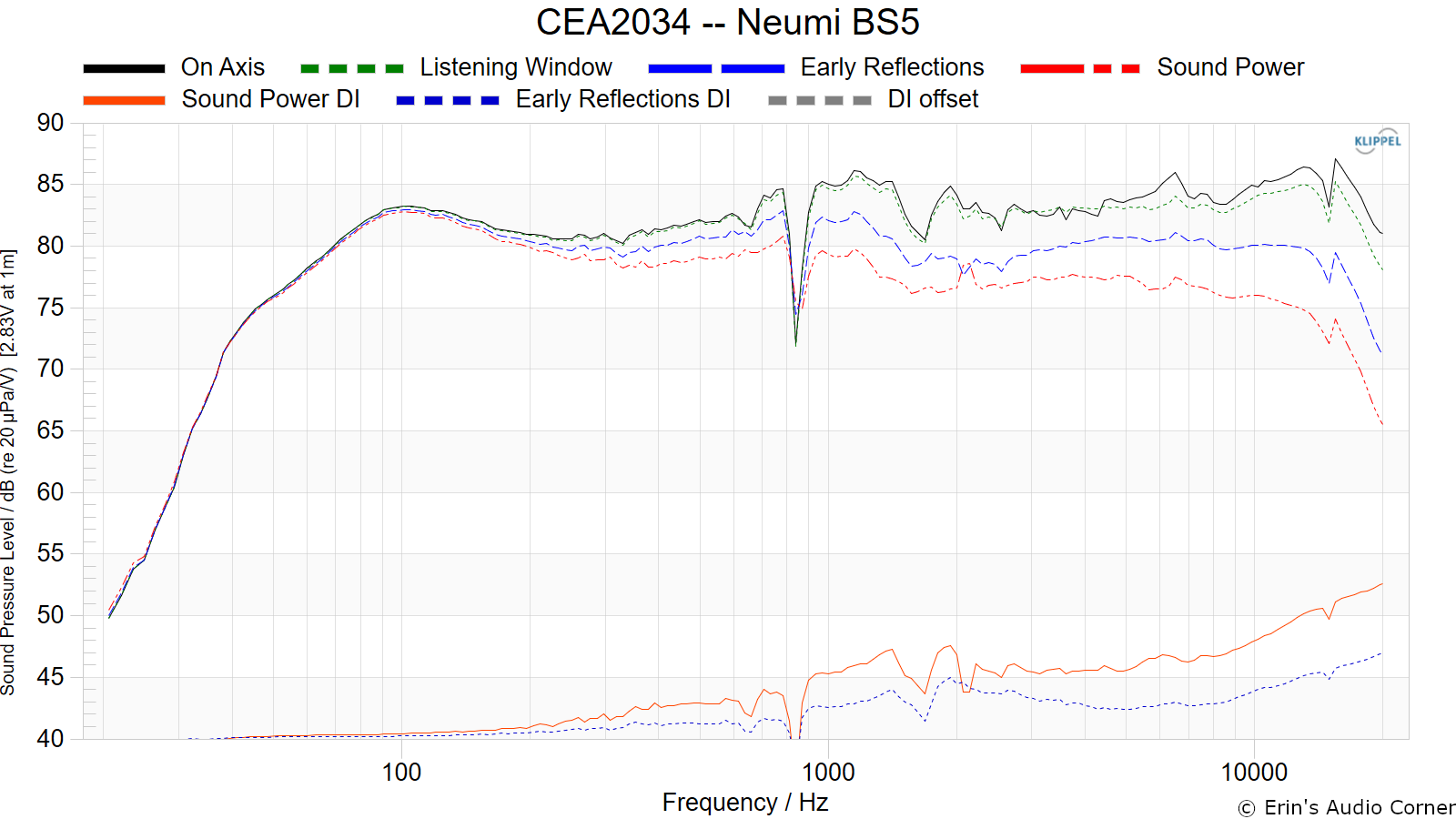
Early Reflections Breakout:
Floor bounce: average of 20º, 30º, 40º down
Ceiling bounce: average of 40º, 50º, 60º up
Front wall bounce: average of 0º, ± 10º, ± 20º, ± 30º horizontal
Side wall bounces: average of ± 40º, ± 50º, ± 60º, ± 70º, ± 80º horizontal
Rear wall bounces: average of 180º, ± 90º horizontal
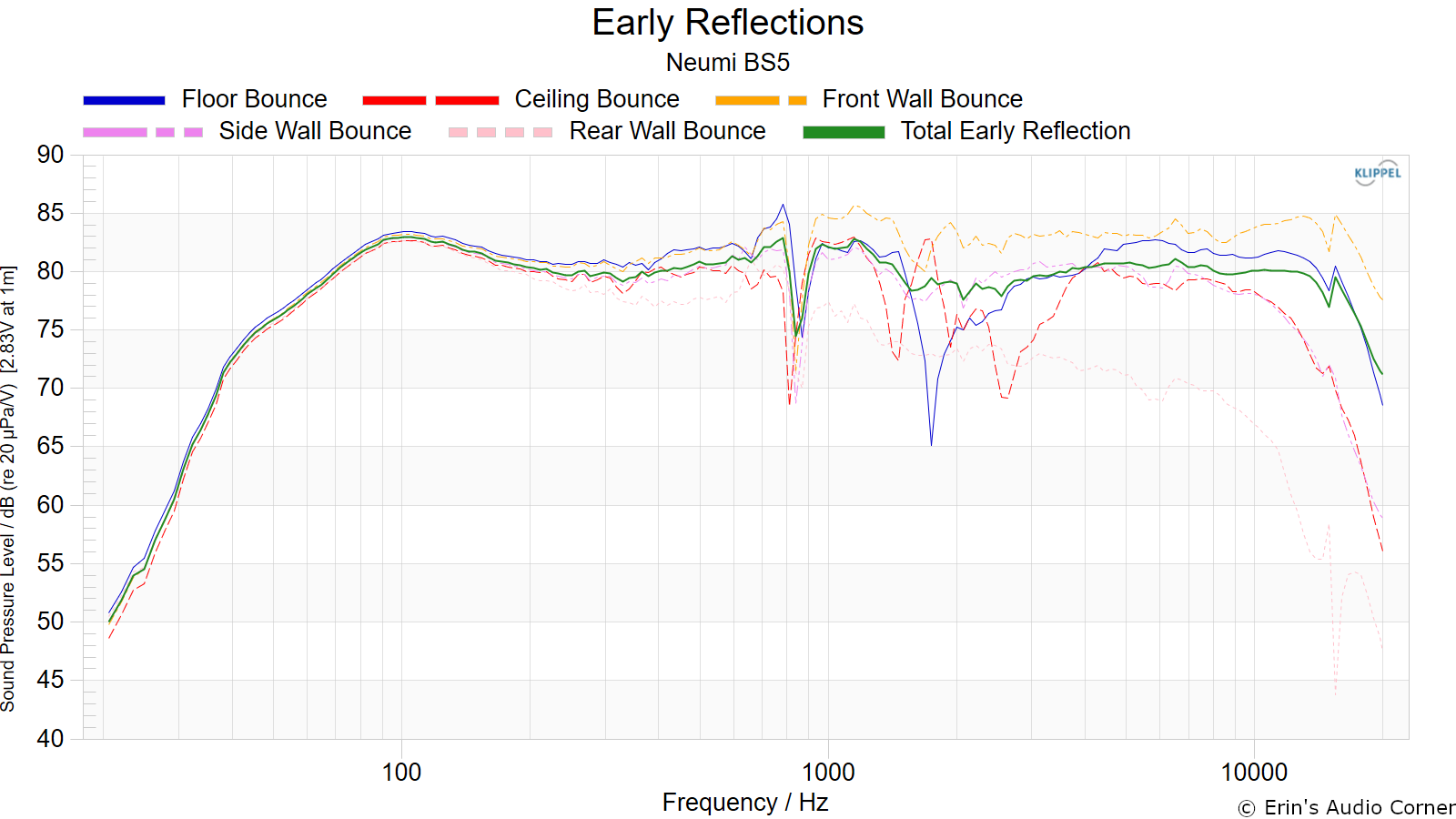
Estimated In-Room Response:
In theory, with complete 360-degree anechoic data on a loudspeaker and sufficient acoustical and geometrical data on the listening room and its layout it would be possible to estimate with good precision what would be measured by an omnidirectional microphone located in the listening area of that room. By making some simplifying assumptions about the listening space, the data set described above permits a usefully accurate preview of how a given loudspeaker might perform in a typical domestic listening room. Obviously, there are no guarantees, because individual rooms can be acoustically aberrant. Sometimes rooms are excessively reflective (“live”) as happens in certain hot, humid climates, with certain styles of interior décor and in under-furnished rooms. Sometimes rooms are excessively “dead” as in other styles of décor and in some custom home theaters where acoustical treatment has been used excessively. This form of post processing is offered only as an estimate of what might happen in a domestic living space with carpet on the floor and a “normal” amount of seating, drapes and cabinetry.
For these limited circumstances it has been found that a usefully accurate Predicted In-Room (PIR) amplitude response, also known as a “room curve” is obtained by a weighted average consisting of 12 % listening window, 44 % early reflections and 44 % sound power. At very high frequencies errors can creep in because of excessive absorption, microphone directivity, and room geometry. These discrepancies are not considered to be of great importance.

Horizontal Frequency Response (0° to ±90°):

Vertical Frequency Response (0° to ±40°):
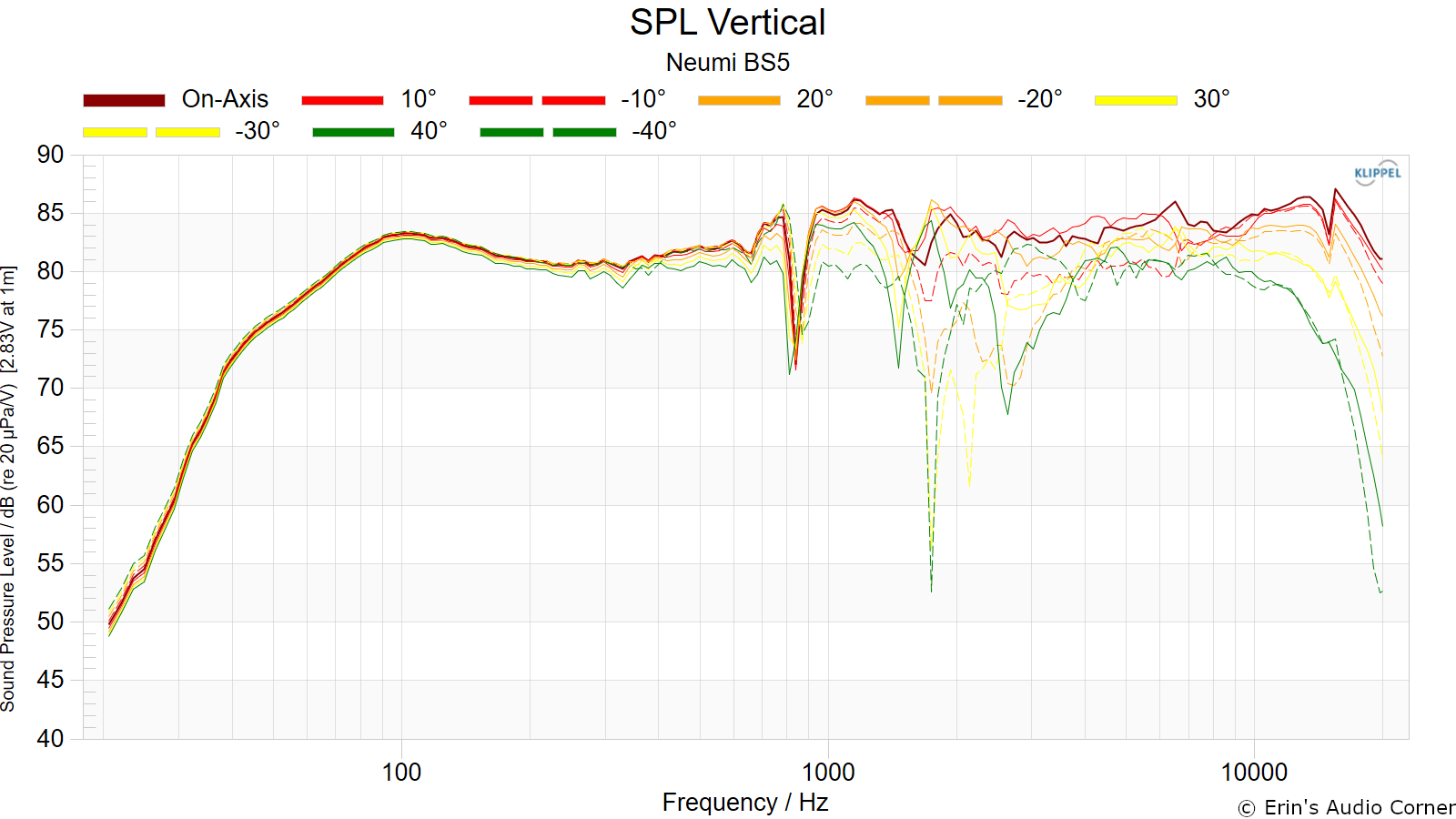
Horizontal Contour Plot (not normalized):

Horizontal Contour Plot (normalized):
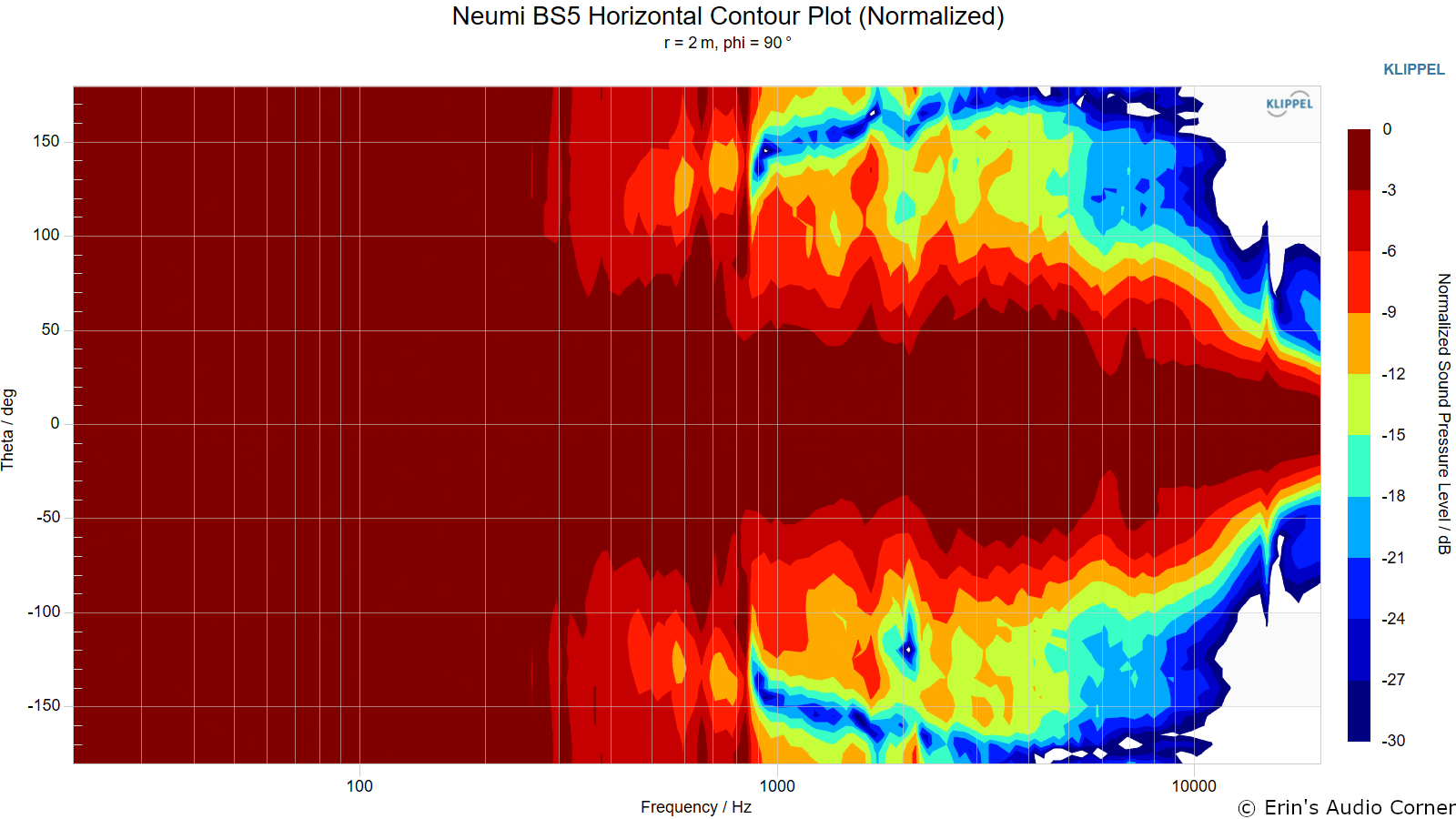
Vertical Contour Plot (not normalized):
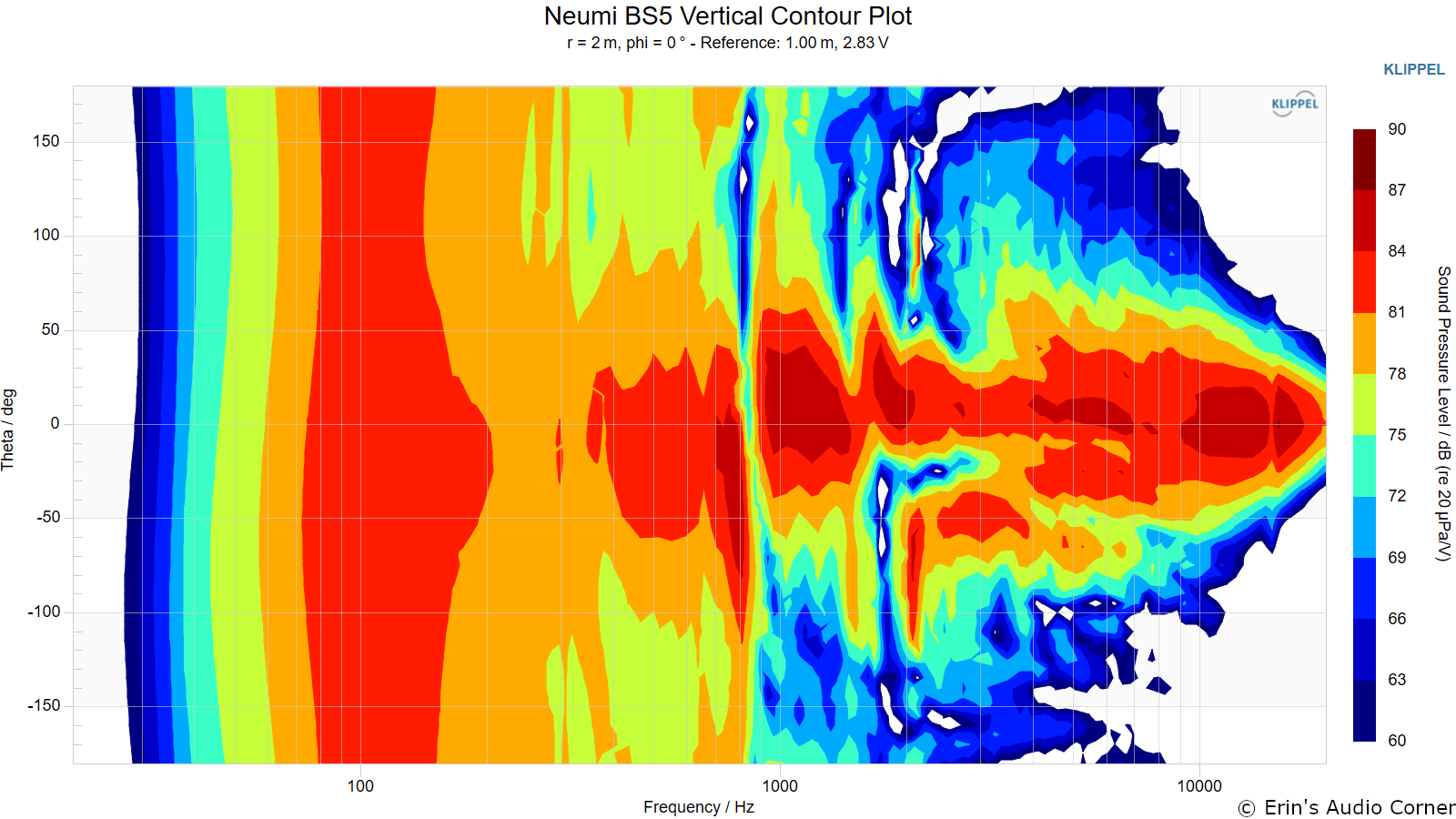
Vertical Contour Plot (normalized):
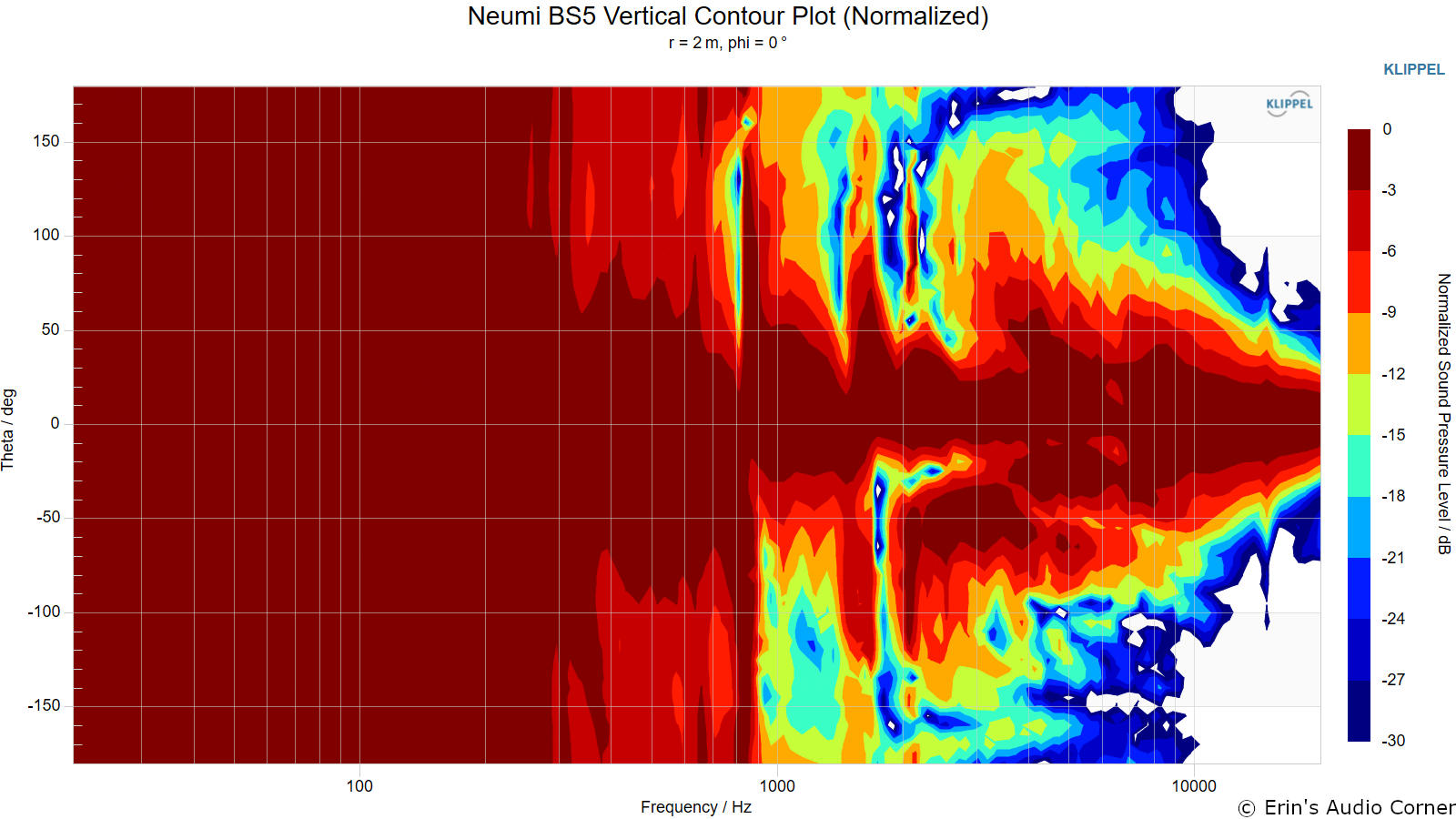
“Globe” Plots
Horizontal Polar (Globe) Plot:
This represents the sound field at 2 meters - above 200Hz - per the legend in the upper left.

Vertical Polar (Globe) Plot:
This represents the sound field at 2 meters - above 200Hz - per the legend in the upper left.

Additional Measurements
On-Axis Response Linearity
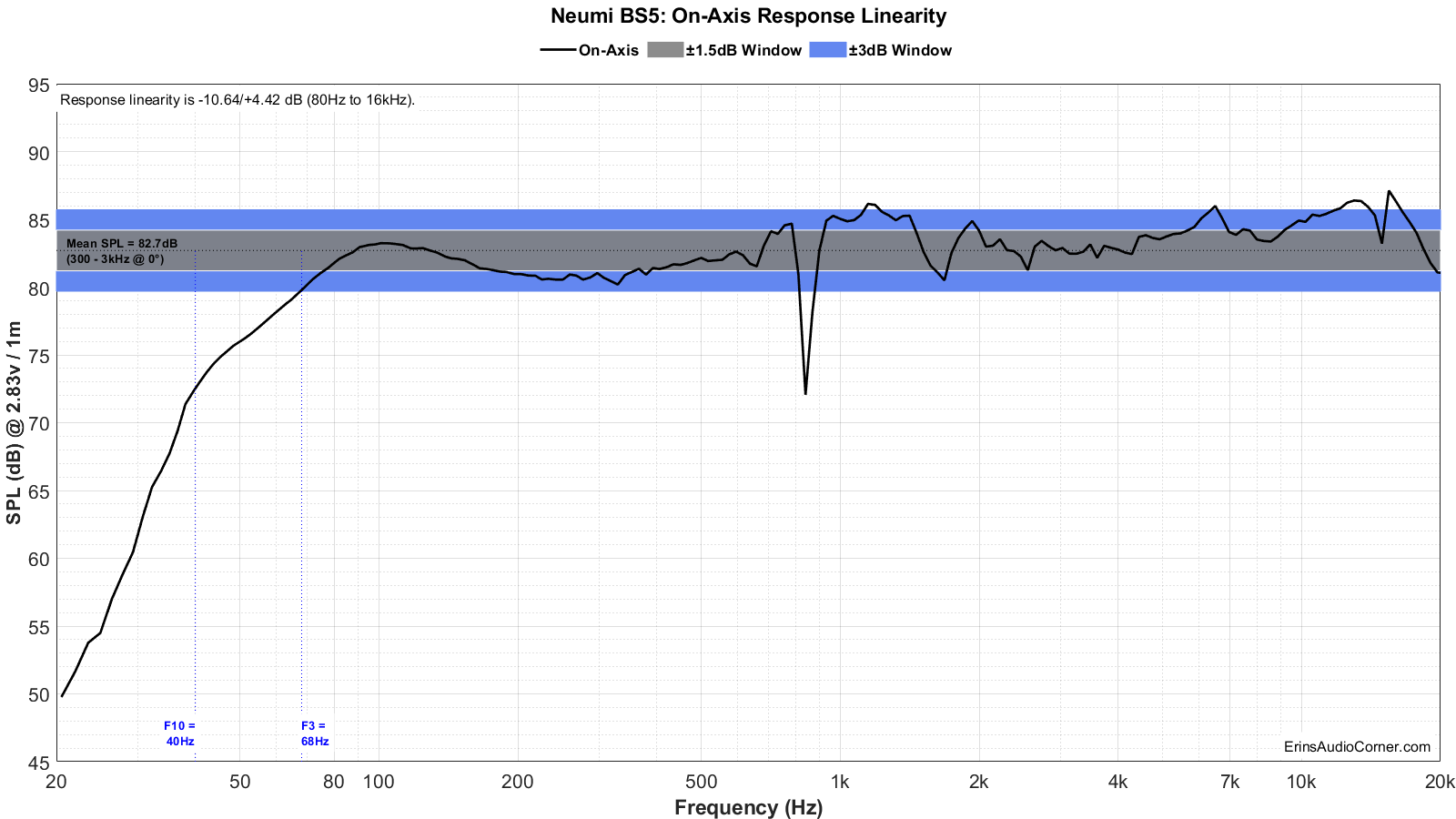
Impedance Magnitude and Phase
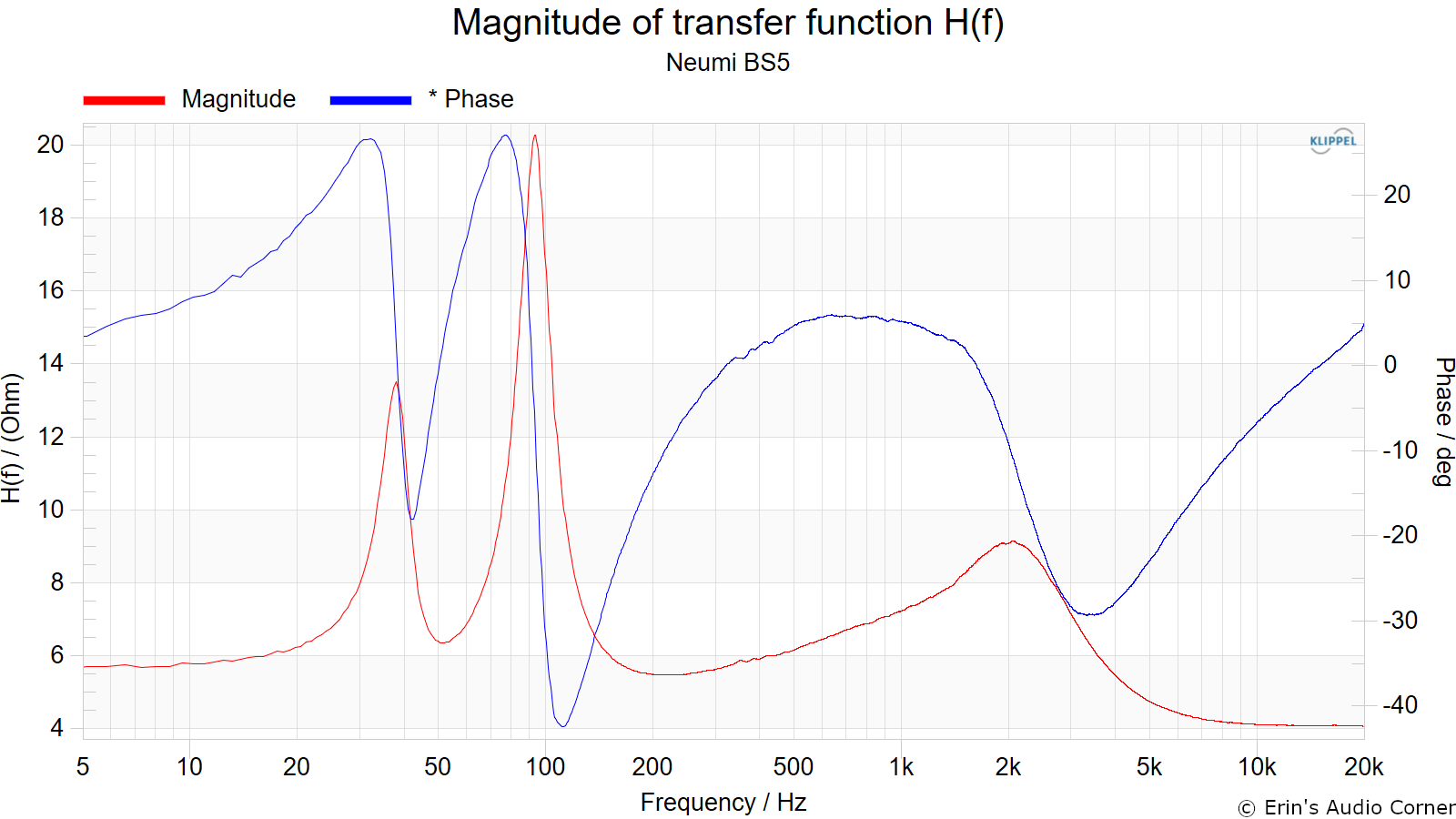
Harmonic Distortion
Harmonic Distortion at 86dB @ 1m:

Harmonic Distortion at 96dB @ 1m:
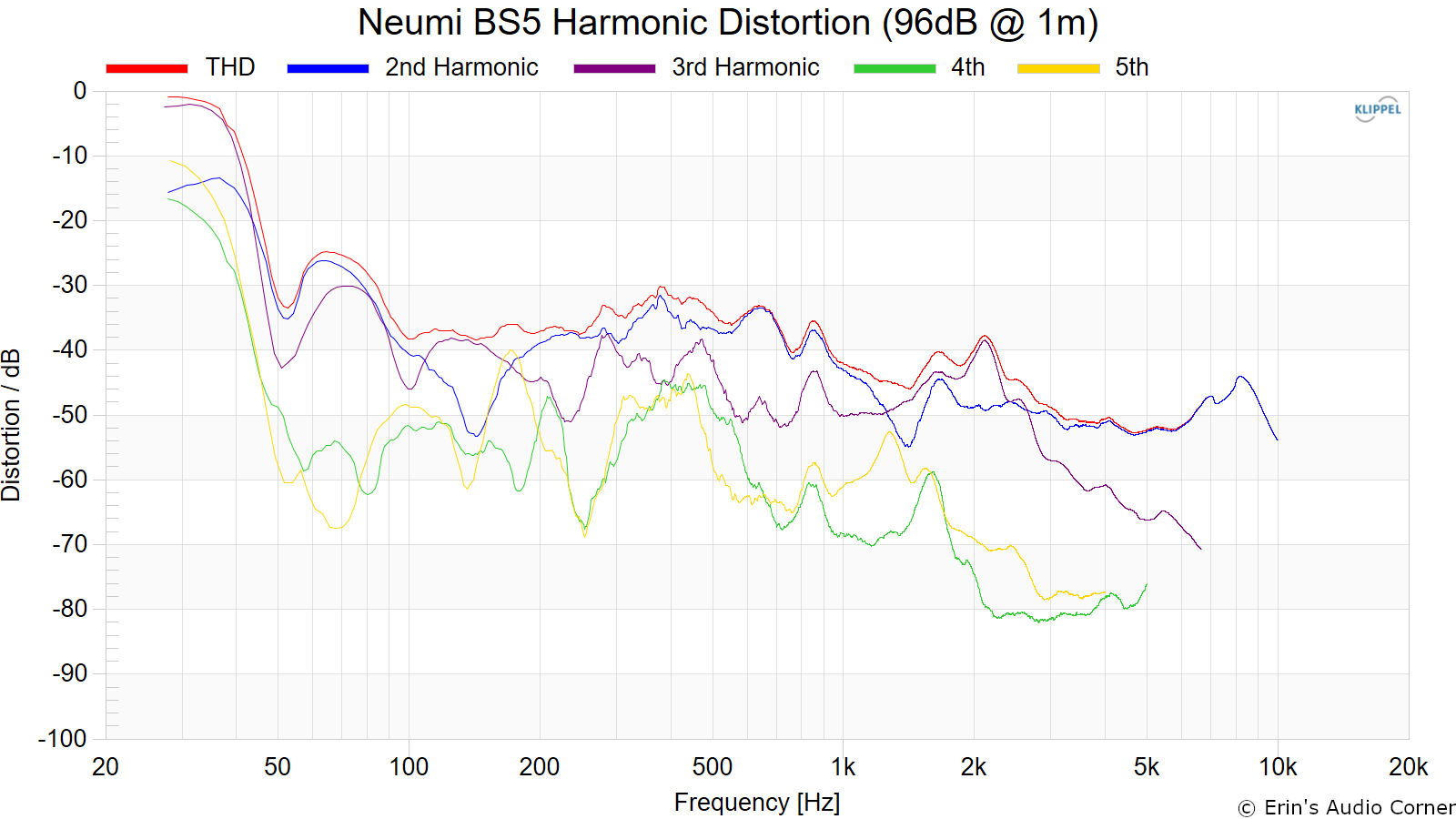
Dynamic Range (Instantaneous Compression Test)
The below graphic indicates just how much SPL is lost (compression) or gained (enhancement; usually due to distortion) when the speaker is played at higher output volumes instantly via a 2.7 second logarithmic sine sweep referenced to 76dB at 1 meter. The signals are played consecutively without any additional stimulus applied. Then normalized against the 76dB result.
The tests are conducted in this fashion:
- 76dB at 1 meter (baseline; black)
- 86dB at 1 meter (red)
- 96dB at 1 meter (blue)
- 102dB at 1 meter (purple)
The purpose of this test is to illustrate how much (if at all) the output changes as a speaker’s components temperature increases (i.e., voice coils, crossover components) instantaneously.

Long Term Compression Tests
The below graphics indicate how much SPL is lost or gained in the long-term as a speaker plays at the same output level for 2 minutes, in intervals. Each graphic represents a different SPL: 86dB and 96dB both at 1 meter.
The purpose of this test is to illustrate how much (if at all) the output changes as a speaker’s components temperature increases (i.e., voice coils, crossover components).
The tests are conducted in this fashion:
- “Cold” logarithmic sine sweep (no stimulus applied beforehand)
- Multitone stimulus played at desired SPL/distance for 2 minutes; intended to represent music signal
- Interim logarithmic sine sweep (no stimulus applied beforehand) (Red in graphic)
- Multitone stimulus played at desired SPL/distance for 2 minutes; intended to represent music signal
- Final logarithmic sine sweep (no stimulus applied beforehand) (Blue in graphic)
The red and blue lines represent changes in the output compared to the initial “cold” test.
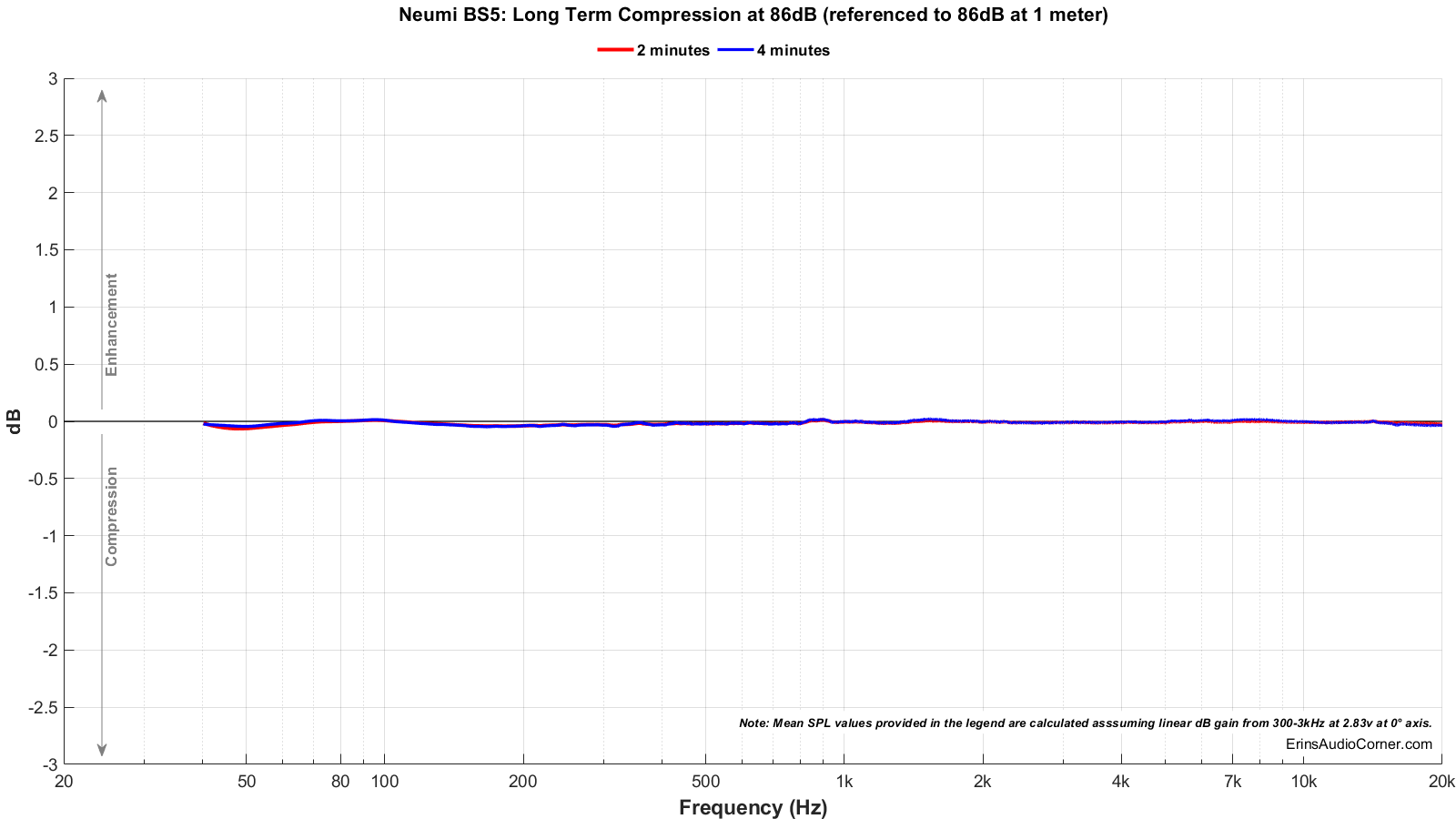

SPINORAMA With the Ports stuffed

Parting / Random Thoughts
If you want to see the music I use for evaluating speakers subjectively, see my Spotify playlist.
I always listen to speakers before I measure them. This ensures I am not swayed by the measurements before I listen. Listening done on-axis but I also turned the speakers to face out into the room as well. I found on-axis to provide the best overall response. Listening volume between 80-95dB at 4m.
- The overall sound of this speaker is reasonably neutral with a few noteworthy points. The midrange dip that occurs from the port tuning and the 1-2kHz resonance. The real issue it faces are the cabinet resonances that leak out the front port. This combination results in a response pattern that is different from other speakers which suffer the same fate. Where those speakers typically have a rear port and suffer an increase in SPL in the back (in-phase with the front drivers), this speaker suffers dips in the front hemisphere because the sound radiated out the port is out-of-phase with the drivers. It’s a classic “pick your poison” scenario. Ideally, none of these speakers would have such resonances and therefore you wouldn’t have to pick, but you do.
- The bass is pretty good for a woofer and cabinet of this size. F3 of 68Hz and F10 of 40Hz means that they’ll still need a subwoofer for sure but will be adequate for most music that doesn’t have low(er) bass if you’re looking for something to pass the time and have a little bit of bump to it.
Like the Sony SS-CS5 I recently reviewed, the Neumi BS5 is a budget darling. It is naturally compromised at its price but overall, I still like the speaker as an option for someone just starting out and on a very limited budget. And I personally prefer the Neumi over the Sony. The Neumi has lower bass extension and a smoother HF. They both have a midrange scoop. The Neumi has the aforementioned issues in the midrange but I don’t find them problematic enough to not still like the overall sound. The good thing is both the Sony and Neumi are cheap enough to buy both, demo both in your own home and then return the pair you don’t like. And as a cheap plug, feel free to use my Amazon affiliate link below.
As stated in the Foreword, this written review is purposely a cliff’s notes version. For more details about the performance (objectively and subjectively) please watch the YouTube video.
Support the Cause
If you find this review helpful and want to help support the cause there are a few ways you can do so below. Your support helps me pay for new items to test, hardware, miscellaneous items needed for testing and costs of the site’s server space and bandwidth. Any help is very much appreciated.
Or using my Amazon affiliate link, if you are interested in these speakers, which helps me gain a small commission at no additional cost to you.
You can also join my Facebook and YouTube pages if you’d like to follow along with updates.